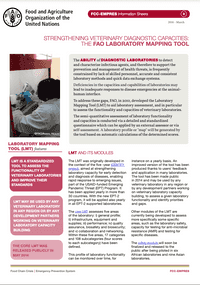Labratory Mapping Tool
[LMT]
LMT is a standardized spreadsheet-based assessment tool developed to help support national, regional, and global efforts to maintain an effective network of animal health and veterinary public health laboratories. The safety and biosecurity module of the LMT includes 98 measures for laboratory safety and biosecurity.
SUMMARY
The Laboratory Mapping Tool (LMT) is a standardized, spreadsheet-based assessment of veterinary laboratories that is designed to be used in any region throughout the world. It was developed to support national, regional and global efforts to maintain a robust network of animal health laboratories. The LMT assesses five areas: 1. General laboratory profile, 2. Infrastructure, equipment and supplies, 3. Performance, 4. Quality assurance, biosafety and biosecurity, and 5. collaboration and networking. The safety and biosecurity module of the LMT (LMT-S) includes 98 measures derived from the WOAH Terrestrial Manual, which has its own entry in this library, covering administrative, operational, engineering, and personal protective equipment practices. Each of these measures are rated on a four-point scale to generate an overall score, and data collected throughout the assessment is used to generate graphs and tables mapping levels of laboratory compliance with international standards and good practice. The LMT can be redone on an annual basis to monitor laboratory scores over time.
The LMT was developed by the Food and Agriculture Organization of the United Nations (FAO) in 2010 and was first released publicly in 2014. From 2015 to 2017, the LMT-S was used to audit 34 laboratories in 19 countries. As of 2017, the LMT was available in English, French and Thai, but translation to other languages is available upon request. The LMT was originally developed as part of the IDENTIFY project, a 5-year project sponsored by the United States Agency for International Development (USAID) that aimed at strengthening international laboratory capacity for disease surveillance and response.


..png)
